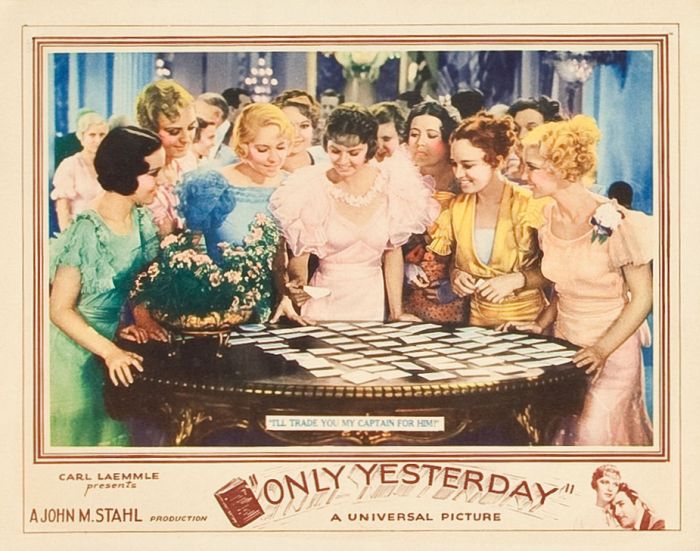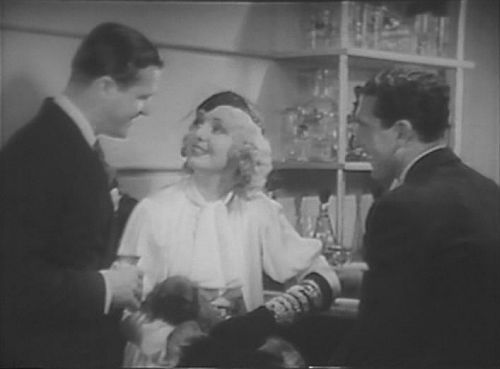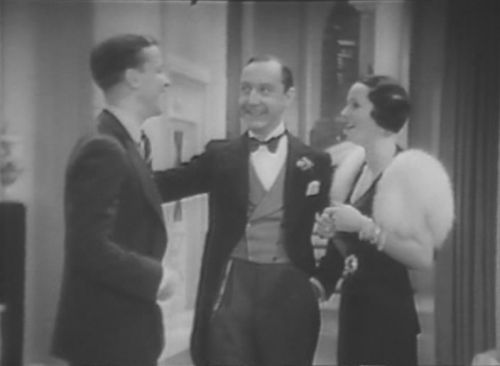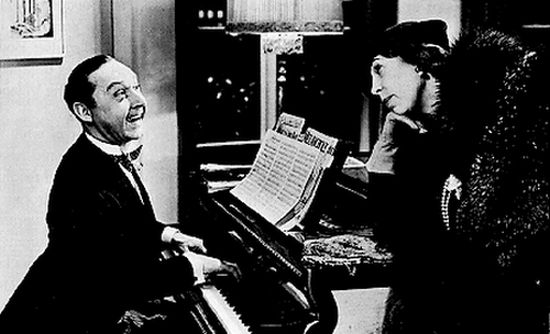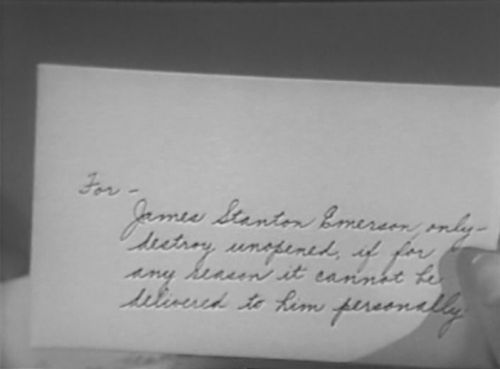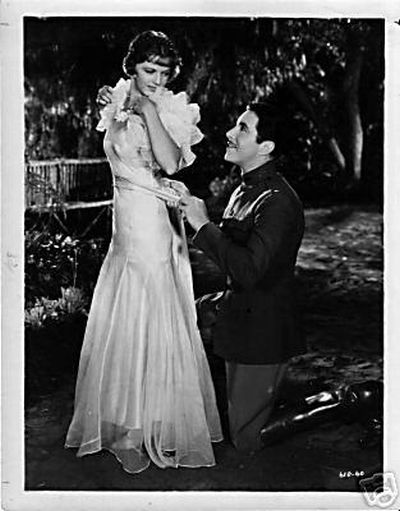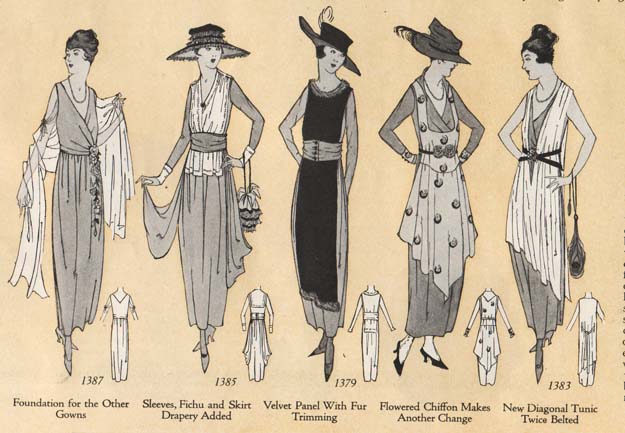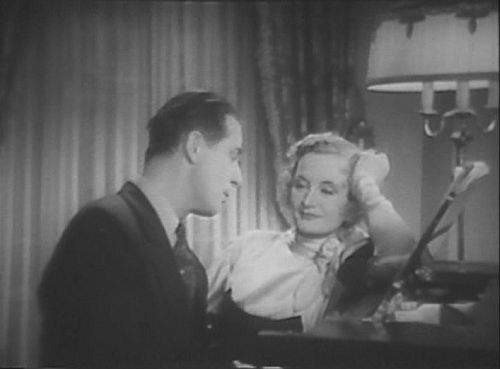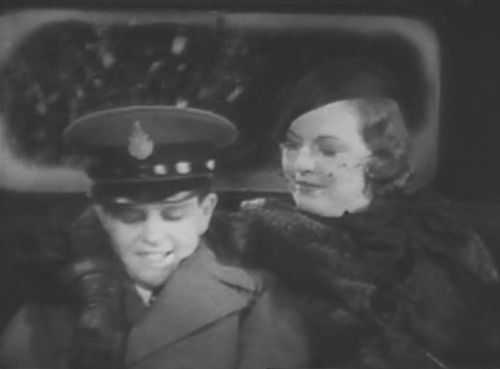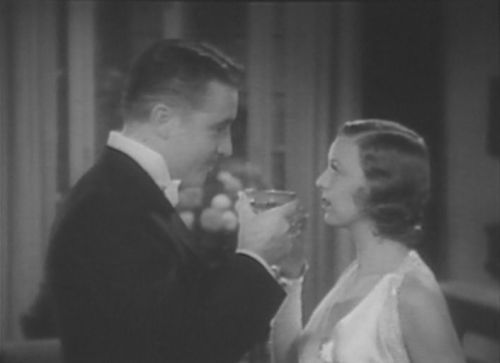For anyone interested in doing research using these posts, please read the note at the bottom of the post. Thank you.
***
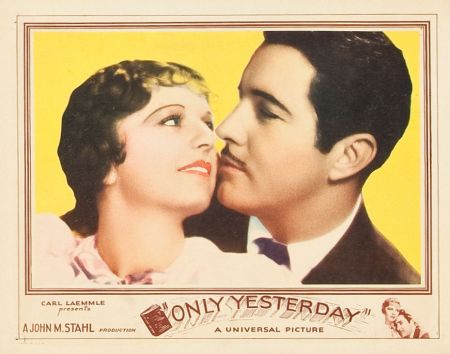 One of the most terrible yet fascinating facets of Marie Prevost’s Hollywood decline is how poorly she was treated in the latter days of her career. Precious little is available about what went on behind the scenes of her films, though one can hardly watch her performances from 1930 on and not realize there was a distinct hostility toward her. Her entrance into pre-Codes was the outre Party Girl (1930), an exploitation flick where her character was a ditzy, high-class prostitute, though savvy in her particular field, completely in control of her own body and career. That role was not a particularly huge step from her 1928 appearance in The Racket, both roles being women of the night, streetwise and desired, though her character is still given a respect in Racket that is noticeably absent in the midst of Party Girl’s exploitation antics.
One of the most terrible yet fascinating facets of Marie Prevost’s Hollywood decline is how poorly she was treated in the latter days of her career. Precious little is available about what went on behind the scenes of her films, though one can hardly watch her performances from 1930 on and not realize there was a distinct hostility toward her. Her entrance into pre-Codes was the outre Party Girl (1930), an exploitation flick where her character was a ditzy, high-class prostitute, though savvy in her particular field, completely in control of her own body and career. That role was not a particularly huge step from her 1928 appearance in The Racket, both roles being women of the night, streetwise and desired, though her character is still given a respect in Racket that is noticeably absent in the midst of Party Girl’s exploitation antics.
It’s impossible to see a strong female character in an exploitation flick as fully respectable, however, as silent star Mildred Davis in the execrable The Devil’s Sleep (1949) proves. She was hired solely as the butt of fat jokes, but Davis is so good-natured, funny, talented and completely unwilling to be humiliated that the jokes don’t work. Instead, her performance makes everyone seem like the rotten bastards they are, which undermines the entire concept of the film. Marie doesn’t quite achieve that sort of subversive performance in Party Girl, though she does single-handedly undercut the self-importance exhibited by the filmmakers and most of the cast, and nearly renders the film entertaining.
Yet Marie looks noticeably older and larger in 1930, and the high pitch of her voice automatically relegated her to sidekicks at best, especially during the era of slightly iffy sound technology. Immediately after Party Girl, Marie was cast in a series of humiliating roles: The fat, dumb prostitute in Ladies of Leisure; the dumb, drunk rich girl in Sporting Blood; the fat, crude good-time girl in Hell Divers; and the fat, unemployable friend in Three Wise Girls, where she is dressed in the ugliest fashions ever seen in a big studio release. In the few decent roles she had from the late silent era on, she played a prostitute.
 Publicity still of Marie Prevost in Only Yesterday.
Publicity still of Marie Prevost in Only Yesterday.
That’s why her small part here in Only Yesterday (1933) must have felt, at least for a moment, like a fresh start. Cast in flashback scenes to the days of World War I as Amy, friend of Mary Lane (headliner Margaret Sullavan), she’s the girl in a bow whose dance card is traded to, or perhaps stolen by, Mary at a swanky party. Amy’s dance card is what gives Mary the chance to meet the man she has been dreaming about for years, the suave Jim Stanton (John Boles).
A fresh start… except the entire role of Amy has been left on the cutting room floor, save one brief, blurry glimpse of Marie in the background:
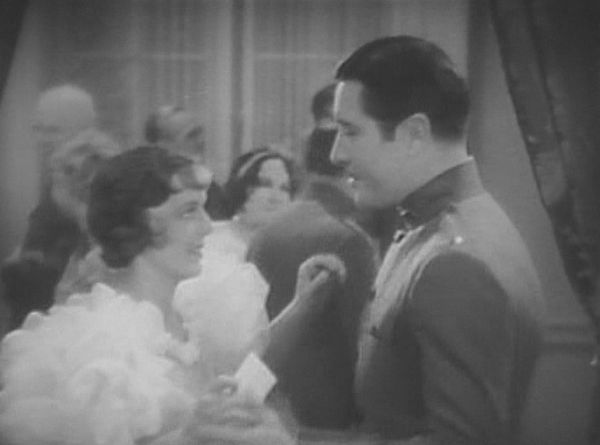
Thus far, I have only found one piece of promotional material with Marie in it. Her head is peeking out over the shoulder of the girl in yellow:
In what may not have been a coincidence, a blonde Bathing Beauty starlet appears in one of the allegedly humorous moments during Only Yesterday’s fabulous 1929 party, where the 1933 audience is dragged from conversation to conversation to ostensibly chuckle at how outdated and silly people were back in the dark ages.
This lovely blonde explains to some attentive men that being a Bathing Beauty is great and all, but she wants a “simple life” with a home and babies. She then proves herself to be the silly little woman everyone knows a Bathing Beauty to be by talking to her lapdog in baby speak, then discovering the dog has piddled on her skirt.
American culture changed rapidly in the late 1920s and early 1930s. Technical advances in the production of 78 RPM records, national radio programs and talking pictures came at the same time much of the Western world was suffering from economic troubles, thanks to the stock market crash and the post-war international economy. It was a cultural climate no longer disposed to unimportant diversions, but rather a culture that needed entertainment as a distinct coping mechanism against a world where adversity overwhelmed optimism. Frivolity was a luxury very few people could afford.
If you want to know how people viewed the Bathing Beauties in the early 1930s, you cannot do any better than watching Only Yesterday. Marie’s scenes being cut illustrates the behind-the-scenes attitude toward former Beauties and women who are no longer as young and beautiful as they once were; the blonde in the film illustrates the public opinion of outdated, silly diversions, which is why the character is very literally pissed on. It’s no wonder Gloria Swanson was angered if anyone dared suggest she had once been a Beauty. The last thing she wanted was this negative public opinion heaped on her, though even mega-star Swanson couldn’t escape the public’s disdain for anything that embodied the carefree 1920s.
In fact, the entirety of Only Yesterday is a rather clumsy attempt to play on the public’s new anger toward 1920s hedonism. In typical reductionist fashion, many people were convinced that outward displays of wealth during the pre-stock market crash days were indicative of moral decay, which is why the audience for Only Yesterday is expected to judge almost everyone at the 1929 party negatively. Those people represent irresponsibility, as do the investors in a brief scene at the stock exchange, and what those characters suffer is deserved.
Marie wasn’t the only familiar face cut from the film. Dozens of well-known character actors played party guests or businessmen in the background. Most of these character actors cannot be seen and many must have had their parts cut entirely. One of the roles left mostly intact was Franklin Pangborn as a guest heading to Jim’s high-class party in October, 1929. Pangborn has a significant role, as large as Edna Mae Oliver’s, so why he isn’t credited while she is third billed is beyond me.
It’s possible Pangborn’s lack of credit is because he is playing a gay man in the film. Trivia on the IMDb claims the man Pangborn goes to the party with is supposed to be his boyfriend, though I question that, especially since the IMDb also says Pangborn’s character is named Tom. He isn’t; his name is Johnny Ayers, I believe — that’s what it sounds like the butler and Phyllis say, at any rate, so that’s what I will call him. Tom is the man he brings to the party, and he doesn’t seem to know anything about the fabulous Emersons, their daily cocktail parties, or Johnny’s career as a designer, and you’d think a boyfriend would know these things. Perhaps people who say Tom is Johnny’s boyfriend are simply being polite, though I think “date” would be more accurate than “boyfriend.” This bit of dialogue is tame by pre-Code standards, yet blatant enough, I suppose:
JOHNNY: Oh, my dear Phyllis, you look charming, my dear!
PHYLLIS: Hello, Johnny! I’m so glad you came. Who’s that guy you brought with you? Your name?
TOM: Tommy Delaney, thank you.
JOHNNY: Oh, the name doesn’t matter very much, but he’s very thirsty!
The above is a promotional still of Franklin serenading Edna May in a scene cut from the film. Only Yesterday mostly takes place at parties: There is a dance in 1918, the one where Marie’s part was cut; a glamorous fete held on Black Tuesday in 1929, the party Edna May and Franklin attend; and finally, a New Year’s bash apparently held December 31, 1928. One of the character actors allegedly in a party scene is the object of one of my minor obsessions, Craig Reynolds. If he is visible anywhere, it’s briefly standing behind Edna May Oliver with his back to the camera. It’s impossible to tell if it’s him, in part because of a particularly brilliant move by the continuity department, who disappear the poor fellow in the middle of a scene. That is the kind of quality one can expect throughout Only Yesterday.
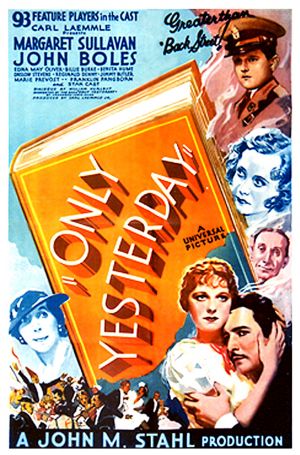 The 1929 party must surely have been originally intended to be a showcase scene, given the enormous scroll of actors listed at the beginning of the film, and at least one poster that advertised “93 feature players in the cast.” It’s possible that was an early poster, however, as it lists Marie Prevost in the cast, but by the time the film was released Marie was uncredited and, as already mentioned, had no scenes left in the film. (And I quite frankly do not know who the older man in red, just below Billie Burke in blue, is supposed to be. Probably another character removed in post.)
The 1929 party must surely have been originally intended to be a showcase scene, given the enormous scroll of actors listed at the beginning of the film, and at least one poster that advertised “93 feature players in the cast.” It’s possible that was an early poster, however, as it lists Marie Prevost in the cast, but by the time the film was released Marie was uncredited and, as already mentioned, had no scenes left in the film. (And I quite frankly do not know who the older man in red, just below Billie Burke in blue, is supposed to be. Probably another character removed in post.)
Yet despite the obvious changes in production, Pangborn’s character makes a big deal of introducing Jim’s apartment as a place where everybody who is anybody is seen, then we promptly see almost nobody recognizable at the party. Somewhere between filming and completion, it appears much of the party scenes were excised, surely in an effort to keep the film from meandering off course and running aground in Boring Tangentland, just off the coast of Box Office Disasterstan.
Jim, by 1929, is a wealthy businessman trapped in a loveless marriage with Phyllis (Benita Hume). Both openly carry on affairs and live a life of giddy luxury. But the stock market has just crashed, and Jim and all his rich friends have lost their wealth. When he finally arrives at the cocktail party, he snipes at Phyllis a bit, rudely informs his current girlfriend that she is dead broke, then locks himself in his office, intent on killing himself. Just before grabbing his gun, he is stopped by the presence of a thick handwritten letter on his desk.
The letter is from his former lover Mary Lane, a girl he spent a night with just prior to heading off to World War I about 11 years earlier. We flash back to the dance Jim meets Mary at, which is of course supposed to be around 1918, but the ladies’ dresses are all the thin fabric, slinky, clingy gowns of the pre-Code era, with a few ruffles added to try to pass them off as fashions of 1918. The copy of the film I have is terrible, as you have guessed by now, so it’s impossible to get a clear screen grab, yet I assure you that behind Jim and Mary on the dance floor are women dressed like this:
…except most have less ruffles than that. Take a gander at a real 1918 dress pattern from Many Hatty Returns:
None of the dresses in the flashback scenes resemble actual fashions of 1918. It’s sloppy, but more than that, it’s detrimental to the entire plot. When you’re dealing with a convoluted storyline — the film takes place in 1929 despite being released in 1933, and flashes back to both 1918 and late 1928 — you have to anchor each year visually. With the stars looking the same age in all their scenes, minus a tiny bit of mayonnaise on John Boles’ temples in later years, costumes have to do most of the heavy lifting to make the storyline flow. The costumes in Only Yesterday completely fail to do anything but confuse.
Of course, since the film never makes it to current-day 1933, confusion is inevitable. Based on the 1922 best seller Letter From an Unknown Woman, the plot has been significantly changed from the book to Americanize it, I suppose, though in doing so it makes absolutely no sense. The novel features the Jim character as a writer and Mary as someone who has known him her whole life; the far superior 1948 film version changes Jim to a pianist, makes a few geographical variations, but otherwise remains true to the novel. Only Yesterday, unfortunately, dispenses with many of the motivations and characterizations that would clarify everyone’s actions, which goes a long way to explaining why very few people realize this was the first film adaptation of Letter From an Unknown Woman.
Mary Lane was a teenager in 1918, a girl who had heard about the charismatic Jim and pretended to know him, going so far as to send herself flowers and claim they were from him. After taking Amy’s dance card which already had Jim penciled in — the dance card scene, shown in the lobby card with Marie above, was one of the party scenes deleted — Mary lets Jim briefly believe she is Amy, then spills her entire stalkery plot. Jim is so flattered that he bones her about an hour later, and pledges his love to her forever.
Which is why he never writes her back once he is shipped off to war. Mary, pregnant of course, goes to live with her liberated aunt in New York, played by Billie Burke. Her aunt is fabulous, but the clumsy dialogue to try to remind everyone that this really is 1918 makes the scenario laughable. Mary, in describing her aunt to a friend, says, and I quote directly, “She is a… oh, what do you call it? A suffragette!”
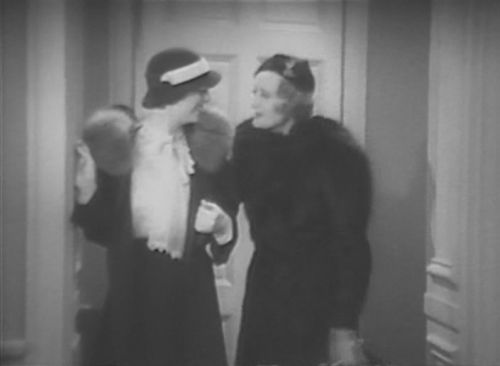 This is totally, like, 1918, you guys.
This is totally, like, 1918, you guys.
Again, Mary and her aunt are in obviously late-1920s and early-1930s fashions despite this being 1918. They talk of bobbing hair, which wasn’t quite a style or political statement yet, and wear cloche hats, which were definitely not popular until the 1920s. Mary’s aunt speaks of the 19th Amendment as though it was decades away, though in truth it was suggested first in the 1870s, and finally submitted to Congress in 1919, only a few months after this scene supposedly takes place. And while we’re at it, I must point out that the Bathing Beauty in the 1928 party scene was mostly an anachronism, as Sennett’s Bathing Beauties were discontinued that year after falling out of the public’s favor by the mid-1920s. The blonde Beauty would have been much more appropriate in the 1918 party scenes. That is how confused this film is.
It’s boggling that the writers would be unable to craft believable scenes that were based on 1918, which was only 15 years prior. Both writer William Hurlbut and director John M. Stahl first worked in film the mid 1910s, so were clearly familiar with the time. Plenty of actors on set — Marie, Billie Burke, Edna May Oliver, King Baggot, Creighton Hale, Bert Roach and a half-dozen others — were active in and around 1918, too. The constant confusion between 1918 and 1929 is incredible, and is the biggest detriment to this film.
Mary’s baby is born on the day the armistice with Germany was signed — that’s November 11, 1918, and the reason I was able to date the rest of the flashback scenes, though time passes not in a straight line in Only Yesterday, but rather in a crooked meander. The landmarks of time are fluid and make little sense, so one can only approximate. Jim returns from the war and immediately finds his girlfriend Phyllis and her family in the parade crowd, but when he sees Mary and speaks to her, he clearly has no idea who she is. What a nice guy.
Mary continues to live with her aunt and her aunt’s younger boyfriend Bob, who the aunt calls “a jackass” at one point, then follows it up with a good old fashioned “pianist” pun, reminding us all that this is indeed a pre-Code. Bob is played by Reginald Denny, the epic dink from Madam Satan (1930), though he is quite good in Only Yesterday and his scenes with Burke are the highlights of an otherwise dreary film.
After several years, Mary has become a successful single mother and businesswoman, whose son is sent off to military school regularly but who has come home for the Christmas holidays in 1928. The improbably-named Jim Emerson, Jr. (we’ll get to this kid’s name in a minute) is played by Jimmy Butler, child and teen star of the 1930s and 1940s. Only Yesterday was his first film, and though he apparently never signed with a studio, he got plenty of work with all the major studios in some fine films such as Manhattan Melodrama, Stella Dallas, Boys Town and The Hard Way. Butler sadly died in battle in France two days before his 23rd birthday, in February, 1945.
Mary naming her son Jim Jr. while steadfastly refusing to tell Jim Emerson, Sr. that he has a son makes very little sense. The elder Jim is a well-known socialite and wealthy man, and even though the child is sent off to military school, people are going to hear his name and immediately wonder if he’s related to the famous Jim Emerson. If you’re familiar with the book or the 1948 film, there is an explanation for Mary not telling Jim about his son, though absolutely none is proffered up here. Mary sends Jim Sr. telegrams every New Year’s “from one who does not forget,” and of course he has no idea who the telegrams are from. On New Year’s Eve in 1928, she sees Jim at a party, and he takes her home with him. She wanders around his apartment being aloof and refusing to reveal her name, eventually sleeping with him again before going home, leaving a very confused Jim behind and a very confused audience wondering what the hell is going on in this lady’s head.
The proud, wronged woman is a common enough conceit in films, though even in solid movies, it was never enough to hang a plot on. Here, Mary’s behavior is frustrating, passive-aggressive and bitter, while Jim is such a dimwitted soul that it’s difficult to believe he’s a cad. He’s weak and stupid, so when she pulls these telegram pranks on him, you start to feel badly for the guy; by the time she’s playing mind games with him in his apartment, it’s hard to sympathize with Mary, who comes across as several crackers short of a snack pack.
The explanation for another dalliance with Jim, inasmuch as one is offered, which it technically isn’t, is that the audience is to presume that Mary’s heart condition lead to a fling with Jim as a last-ditch effort at… something. The other possibility is that the film never deigned to explain the fling at all, rendering it and Mary’s illness as completely unrelated plot points. She writes Jim a lengthy letter explaining who she is, that they have a son, et cetera in melodramatic fashion, and then has it delivered to him when she dies, which is the day he was about to blow his brains out because the stock market went tits up.
This all displays an unconscionable lack of responsibility on either Jim’s or Mary’s part, with Jim never even considering that he might get women pregnant after sleeping with them. He is pretty dim in this film, so perhaps he was he never informed that this is how it works. Jim’s dullness does not do either actor John Boles or the character of Jim Emerson any justice, and is one of the most offensive parts of the film. As for Mary, she rather irresponsibly named this kid after the father he doesn’t know he has, and relied on this letter getting to Jim when she died so their son won’t be an orphan. All for the sake of romantic sensibilities, one supposes, though it’s clear neither of these grown-ass adults for one moment thought about their child, the 10-year-old who is going to lose his mother and get a stranger for a father all in the same day.
Only Yesterday was Margaret Sullavan’s film debut, and while I understand she is something of a favorite with classic film buffs and critics, I have never warmed up to her. She is overly mannered, cold and lacking in charisma. Sullavan, however, gives an affecting performance in her death scene, which is understated and strangely reminiscent of Terms of Endearment.
Her chilly performance, paired with a disinterested John Boles and with dialogue not so much written as hastily cribbed together from a pile of diner napkins someone scribbled a bunch of unrelated ideas on, Sullavan by all rights should never have become a film star. That she did is the biggest surprise of the film. The second biggest surprise is the almost universal praise for this stinker of a movie. It’s not all bad, as the few solid secondary players almost make the film entertaining, but they get so little time that their efforts are in vain. The sets are dull, the fashions hilarious, and the plot massacred from a decent one they apparently had the rights to but ignored.
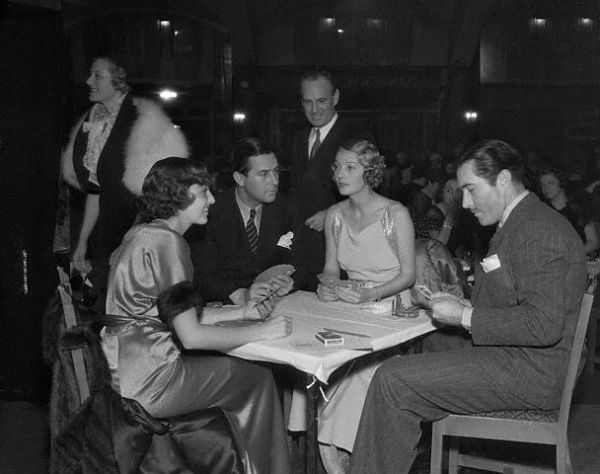 John Boles, far right, at a February, 1934 charity bridge tournament hosted by Marion Davies. From left to right: Mrs. Zeppo Marx, Ben Lyon, Dorothy MacKaill, and John Boles.
John Boles, far right, at a February, 1934 charity bridge tournament hosted by Marion Davies. From left to right: Mrs. Zeppo Marx, Ben Lyon, Dorothy MacKaill, and John Boles.
Only Yesterday is astonishingly difficult to find. A truly rotten print is on YouTube and collector’s copies are available, apparently from a slightly different print, as more of the bottom of the frame is available on the YouTube version. It appears at times at festivals, and if you get a chance to see it, you’ll want to. Just don’t expect too much of the plot, the continuity, the acting, or to see a glimpse of your favorite character actor in the background.
***
If you’re interesting in using these posts for research, please note the following:
1) You can use my blog posts for sources, but they must be credited in footnotes or bibliography (as should any book, blog, magazine, or other source). You cannot just cut and paste sections of my blog into your own work. Please know that I will not just ignore copyright infringement, should it occur.
2) There may be errors in my blog posts. You’re responsible for doing your own research and verifying anything you read.
3) I will not help you with your Marie Prevost research. Please don’t ask.
4) I own some memorabilia, photos, archival docs, etc., but I do not lend them out for any reason. Please don’t ask.
5) Despite any claim you may have heard to the contrary, I have not assisted nor collaborated with anyone in their book or article on Marie Prevost.
For more details, read here. Thank you for understanding.

